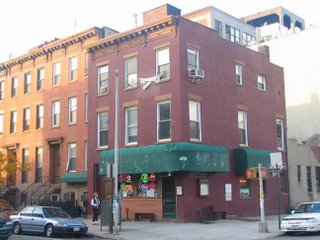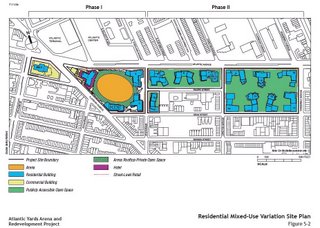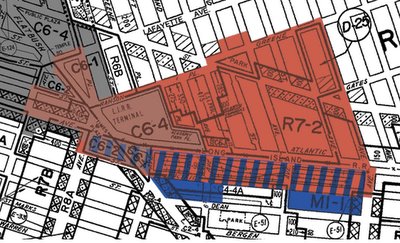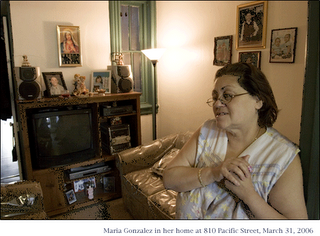 For years, Develop Don’t Destroy Brooklyn (DDDB) has complained that the process behind the Atlantic Yards project was a sham. Yesterday, the community coalition put some legal muscle behind it. Ten plaintiffs—three property owners, one commercial tenant, and six residential tenants—filed suit in federal court, calling the planned use of eminent domain unconstitutional.
For years, Develop Don’t Destroy Brooklyn (DDDB) has complained that the process behind the Atlantic Yards project was a sham. Yesterday, the community coalition put some legal muscle behind it. Ten plaintiffs—three property owners, one commercial tenant, and six residential tenants—filed suit in federal court, calling the planned use of eminent domain unconstitutional.(Photo of attorney Matthew Brinckerhoff by Jonathan Barkey)
In doing so, they asked that the Empire State Development Corporation (ESDC) and Public Authorities Control Board (PACB) halt any action to approve the project. (Developer Forest City Ratner (FCR) has predicted approval next month.)
 Named as defendants are FCR and associated entities, the ESDC, the New York City Economic Development Corporation (NYCEDC), as well as Gov. George Pataki, ESDC Chairman Charles Gargano, Mayor Mike Bloomberg, Deputy Mayor Dan Doctoroff, NYCEDC officials Andrew Alper and Joshua Sirefman, and FCR’s Bruce Ratner and Jim Stuckey. All of the plaintiffs are in blocks below the MTA’s Vanderbilt Yard, including two from this block of five houses on Dean Street just east of Sixth Avenue.
Named as defendants are FCR and associated entities, the ESDC, the New York City Economic Development Corporation (NYCEDC), as well as Gov. George Pataki, ESDC Chairman Charles Gargano, Mayor Mike Bloomberg, Deputy Mayor Dan Doctoroff, NYCEDC officials Andrew Alper and Joshua Sirefman, and FCR’s Bruce Ratner and Jim Stuckey. All of the plaintiffs are in blocks below the MTA’s Vanderbilt Yard, including two from this block of five houses on Dean Street just east of Sixth Avenue.At a press conference yesterday afternoon outside City Hall, plaintiffs’ lead attorney Brinckerhoff called the planned project a violation of the 2005 Supreme Court decision in the Kelo v. New London case: “This lawsuit presents a textbook example of what the Fifth Amendment expressly prohibits: the taking of one citizen’s property in order to benefit a powerful and influential private citizen,”
(His firm, Emery, Celli, Brinckerhoff & Abady (ECBA), has won some significant victories challenging government action, gaining New York City to pay $4.8 million to Housing Works, after the city terminated the group’s funding in response to its criticism of the city, and obtaining $50 million settlement from the city in a class action suit representing more 60,000 people arrested for minor violations who were strip-searched. It has also helped preserve the historic High Line on the West Side, which had faced demolition.)
Kelo permitted the use of eminent domain, but it indicates that there must be a planning process—which differs from the process in Brooklyn, according to the complaint. (The opinion stated: "The City has carefully formulated an economic development plan..." Justice Anthony Kennedy's concurrence emphasized "that respondents reviewed a variety of development plans and chose a private developer from a group of applicants rather than picking out a particular transferee beforehand.") Brinckerhoff acknowledged that the Kelo decision did erode some rights, but emphasized that “the Supreme Court has always said you cannot take private property for a private benefit.” Jurisprudence has evolved to allow a broadly-defined "public purpose," however.
 Added plaintiff and DDDB spokesman Daniel Goldstein, “When Bruce Ratner went to Governor Pataki and asked if he could take our homes and businesses, and the governor said ‘sure,’ what he did was create the lawsuit you see today.”
Added plaintiff and DDDB spokesman Daniel Goldstein, “When Bruce Ratner went to Governor Pataki and asked if he could take our homes and businesses, and the governor said ‘sure,’ what he did was create the lawsuit you see today.”(Photo of Goldstein by Jonathan Barkey)
Why sue now, even before the ESDC has voted? Brinckerhoff responded, “The plantiffs have an absolute right to have claims heard in federal court. If we wait, that would be jeopardized.” While he said that the plaintiffs have enough evidence to go to trial, he predicted that, during the discovery phase, “We will find documents that support our theory that this decision was made years ago.” By filing in federal court rather than state court, the plaintiffs also seek redress in a forum that is more insulated from the local political winds.
(The judge assigned is Nicholas Garaufis, who was appointed by President Bill Clinton in 2000 after serving as the Chief Counsel of the Federal Aviation Administration in Washington, D.C. and before that counsel to Queens Borough President Claire Shulman.)
Goldstein said the issue was of national importance and, indeed, DDDB offered a statement of support from the Institute of Justice (IJ), the libertarian law firm that has led the fight against eminent domain abuse. IJ attorney Dana Berliner, co-counsel for the plaintiffs in the Kelo case, pointed out that the city of New London did not have a developer in mind when it came up with the project; she told the New York Law Journal: "Kelo left open the possibility that a pure one-to-one transfer, or a condemnation that was made not according to the proper planning procedures, would not pass constitutional muster.”
Charges & responses
 Specifically, the lawsuit claims that the condemnations of plaintiffs properties violates the Takings Clause of the Fifth Amendment to the U.S. Constitution and the Equal Protection Clause of the Fourteenth Amendment. It asks not just for a stop in in the condemnations--including Freddy's Bar & Backroom at Dean Street and Sixth Avenue--but also compensatory damages from all defendants and punitive damages from all except the City of New York, as well as attorneys fees.
Specifically, the lawsuit claims that the condemnations of plaintiffs properties violates the Takings Clause of the Fifth Amendment to the U.S. Constitution and the Equal Protection Clause of the Fourteenth Amendment. It asks not just for a stop in in the condemnations--including Freddy's Bar & Backroom at Dean Street and Sixth Avenue--but also compensatory damages from all defendants and punitive damages from all except the City of New York, as well as attorneys fees.Forest City Ratner spokesman Joe DePlasco said, “This is simply a sad attempt to delay a project that is supported by over 60% of Brooklyn." Mayor Bloomberg said, "There are people that want to stop this project in Brooklyn for, I would argue, either misguided, myopic, or selfish reasons," and said the suit had "no real merit." The ESDC did not have an immediate comment.
Process & pretext
 Further arguing that the project had been greased, the lawsuit details “The Sham Bid Process for the Railyards,” citing an RFP “profoundly biased” in favor of FCR, “The Patina of Public Participation,” pointing out how most people who wanted to speak at the Aug. 23 public hearing were rebuffed.
Further arguing that the project had been greased, the lawsuit details “The Sham Bid Process for the Railyards,” citing an RFP “profoundly biased” in favor of FCR, “The Patina of Public Participation,” pointing out how most people who wanted to speak at the Aug. 23 public hearing were rebuffed.(Project outline from ESDC)
The suit charges:
Defendants have attempted to justify the taking of private property for the benefit of a private party on four main grounds: (1) the Project will result in a net economic benefit to the City and State; (2) the taking is necessary to eliminate urban blight; (3) that the Project will create significant affordable housing; and (4) the Project will create thousands of new jobs. These alleged “public benefits” are either wildly exaggerated or simply false.
The suit incorporates several of the arguments made in the ongoing political battle: that the costs of the project are not disclosed or accounted for; that the elimination of blight was never raised as a justification when the project was unveiled in 2003; that only 550 affordable units are slated for Phase I of the project; and that the claimed 15,000 construction jobs are job-years, and that most of the promised 2500 office jobs would be retained rather than new.
Whether that raises constitutional muster is another question. After reading the complaint, David Reiss, who teaches property law at Brooklyn Law School, observed that the plaintiffs face a significant challenge. Despite the criticisms of the determination of blight, courts have left much leeway for government agencies to declare blight. The strongest case for plaintiffs, he suggested, may be the accusation of a sham bid process for the railyards, “if they’re able to demonstrate it.”
As for the claim that the eminent domain action violates plaintiffs’ equal protection of the law, he told me that “courts have typically been very reluctant to find that a government action was not rational. It’s a low standard.”
ATURA & the “Takings Area
The suit claims that eminent domain is unnecessary, since major development could be achieved without taking privately-owned land. “Defendants’ decision to take plaintiffs’ properties serves only one purpose: to allow Ratner to build a Project of unprecedented size and thus to reap a profit that defendants, tellingly, have thus far refused to disclose,” the suit states.
 The lawsuit makes a distinction between parts of the project within ATURA, the Atlantic Terminal Urban Renewal Area, designated in 1968, and the privately-owned land in the “Takings Area,” which is not part of ATURA. (In the map at right, anything in red (including a grayish red, but not the gray alone) is within ATURA. The blue-and-red striped areas between Atlantic Avenue and Pacific Street are within both ATURA and the Atlantic Yards footprint. The blocks in solid blue, which include the plaintiffs' properties and homes on Pacific and Dean streets, are within the Atlantic Yards footprint but not ATURA.)
The lawsuit makes a distinction between parts of the project within ATURA, the Atlantic Terminal Urban Renewal Area, designated in 1968, and the privately-owned land in the “Takings Area,” which is not part of ATURA. (In the map at right, anything in red (including a grayish red, but not the gray alone) is within ATURA. The blue-and-red striped areas between Atlantic Avenue and Pacific Street are within both ATURA and the Atlantic Yards footprint. The blocks in solid blue, which include the plaintiffs' properties and homes on Pacific and Dean streets, are within the Atlantic Yards footprint but not ATURA.)The lawsuit notes that ATURA has never been expanded to include the Takings Area, nor has the area been designated as blighted or designated for redevelopment. Rather, “the Takings Area rests smack in the middle of some of the most valuable real estate in Brooklyn.” Thus, the suit says, any stagnation in the area is “the result of the Project itself.”
While ATURA could easily be redeveloped without the Takings Area, as the suit alleges, it would be much harder to do so and find space for a basketball arena. And that’s what was offered to the city--and the city wanted it. As former NYCEDC president Alper said at a 5/4/04 meeting of the City Council Economic Development Committee:
This particular project came to us. We were not out soliciting, we were developing a Downtown Brooklyn Plan, but we were not out soliciting a professional sports franchise for Downtown Brooklyn. The developer came to us with what we thought was actually a very clever plan. It is not only bringing a sports team back to Brooklyn, but to do it in a way that provided dramatic economic development catalyst in terms of housing, retail, commercial jobs, construction jobs, permanent jobs. So, they came to us, we did not come to them. And it is not really up to us then to go out and find to try to a better deal.
On the Brian Lehrer Show last July, FCR’s Stuckey said:
This area has been considered blighted since 1968 when the first Atlantic Terminal Urban Renewal Plan was adopted. About 60, 65% of the area fell within that urban renewal area and was considered to be a blighted area. Those findings when the Downtown Brooklyn plan was approved two years ago were reaffirmed.
Plaintiffs
 One plaintiff is the company that runs Freddy’s. Manager Donald O’Finn, a video artist whose works show at the bar, said that “we believe the project is not rationally related to a legitimate public purpose.” He described the bar’s many honors and accolades: “Freddy’s is far more than a business; it’s a beloved institution.”
One plaintiff is the company that runs Freddy’s. Manager Donald O’Finn, a video artist whose works show at the bar, said that “we believe the project is not rationally related to a legitimate public purpose.” He described the bar’s many honors and accolades: “Freddy’s is far more than a business; it’s a beloved institution.”(O'Finn photo by Jonathan Barkey.)
Another plaintiff, David Sheets, has lived for nine-years in a rent-stabilized SRO building on Dean Street. While he didn’t speak at the formal part of the press conference, Sheets—a paralegal of modest means but firm convictions—said afterward, "We read about this in the paper. No one ever had any contact with us [before the project announcement]."
As for joining the lawsuit, he said, “I can’t not. I have to see myself in the mirror every morning. We are being forced out of our homes, either insidiously or directly, to make room for a basketball franchise that does not have legal approval to operate in the state of New York...for a project that has not even been designed." Moreover, he said, no one has signed off on the finances, pointing to Assemblyman Jim Brennan's struggle to gain documents about the development's profit projections.”
 Sheets and five other rental plaintiffs, representing households with a total of 24 people, are represented by South Brooklyn Legal Services (SBLS). “There’s no guarantee that they’d get what they have now,” said SBLS attorney Jane Landry-Reyes. “Moreover, they don’t want to move from their homes.” (One of those plaintiffs is Maria Gonzalez, pictured at right, who has lived in her Pacific Street building for 33 years. Photo by Dan Sagarin.)
Sheets and five other rental plaintiffs, representing households with a total of 24 people, are represented by South Brooklyn Legal Services (SBLS). “There’s no guarantee that they’d get what they have now,” said SBLS attorney Jane Landry-Reyes. “Moreover, they don’t want to move from their homes.” (One of those plaintiffs is Maria Gonzalez, pictured at right, who has lived in her Pacific Street building for 33 years. Photo by Dan Sagarin.)While Forest City said that renters had been offered space in the project at comparable rent and interim rental assistance, attorneys from SBLS said the contracts lasted only three years—not enough time to fully protect them. Moreover, said the lawsuit, the use of “friendly condemnations”--the ESDC will condemn buldings that FCR owns--allows the developer to override state laws that require landlords who are demolishing buildings with rent-regulated tenants to “obtain approval from the State Division of Housing and Community Renewal and must either offer replacement housing at the same rent, a stipend to cover the anticipated difference in rents for a six year period, or some combination of those two options.” (A state lawsuit from other tenants is anticipated, as well.)
Politics and strategy
 City Council Member Letitia James challenged the legitimacy of the project, counting out justifications for the project and repeating, “It was a lie then, and it’s a lie now.” She added, “We could do it right. This project could be subject to community review.”
City Council Member Letitia James challenged the legitimacy of the project, counting out justifications for the project and repeating, “It was a lie then, and it’s a lie now.” She added, “We could do it right. This project could be subject to community review.”(Photo by Jonathan Barkey)
James pointed out that apartments have been selling for $1 million in the neighborhoods. “But anyone definition, that’s not blight. The neighborhood is not blighted.” Also present were State Senator Velmanette Montgomery; Chris Owens, unsuccessful candidate for the 11th Congressional District (and representing his father, retiring Rep. Major Owens); and Bill Batson, Community Board 8 Atlantic Yards committee co-chair and unsuccessful candidate for the 57th Assembly District.
How much money has DDDB raised? Goldstein deflected the question, saying that the group had raised more than $100,000 in its recent walkathon, and that the national attention from the lawsuit will draw more support. “We have pledge commitments of tens of thousands [of dollars],” said DDDB volunteer attorney Adam Perlmutter.
FCR's full response
Forest City Ratner spokesman Joe DePlasco said in a statement, "For over three years we have tried everything in our power to negotiate fair and beneficial transactions for everyone living in the footprint. We have been able to do so with a vast majority of residents and business owners. However, a handful of people have either refused to speak with us or, for whatever reason, we have been unable to reach an agreement with others. It is disappointing they have decided to take this action, but it is not unexpected. The opposition has said repeatedly that its plan is to file as many lawsuits as possible in order to try and delay a project that will provide over 2,200 units of affordable housing, create over 15,000 jobs and generate over $1.4 billion in new net tax revenue for the city and the state. This is simply a sad attempt to delay a project that is supported by over 60% of Brooklyn."
In other words, constitutional law by plebiscite?
It's unclear how closely the court can or will look at the contested issues of jobs, housing, and tax revenue. The lawsuit, however, may point other organizations and media outlets to look at those issues more closely.
Comments
Post a Comment